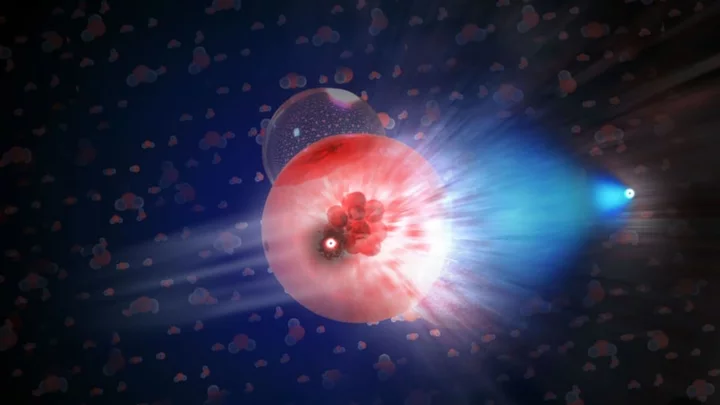Ghost particles. That’s what many physicists call neutrinos, the almost mass-less subatomic particles that are all around us, all of the time. You’d never know it, and it usually takes experiments the size of swimming pools or larger to catch them. But they’re crucial pieces in the particle physics puzzle that describes everything we see in the universe. And they’re freaking weird.
Here are some of the bizarre things physicist Alan Chodos and I found out about neutrinos as we wrote our book Ghost Particle: In Search of the Elusive and Mysterious Neutrino.
1. One hundred trillion neutrinos careen through you each second.
There’s a flood of neutrinos rushing through us, the Earth, and everything around us at about the speed of light. They come from nuclear reactions in the core of the sun. There, protons fusing together into helium put out light, energy and gazillions of neutrinos.
In your entire lifetime, one or two solar neutrinos will hit an atom in your body. But even considering that you’re made of trillions of billions of atoms, you won’t notice a thing.
2. You have roughly 300 neutrinos from the beginning of time in the tip of your pinky.
The flood of neutrinos from the sun is nothing compared to the neutrinos that are the oldest particles in existence. They’re ancient relics of the Big Bang that got the universe going. The relic neutrinos emerged about 13.8 billion years ago when the universe exploded into existence and have been gliding around ever since. They’ve slowed down and spread out as the universe expanded. So, unlike solar neutrinos that zip along at about the speed of light, Big Bang relic neutrinos fill the cosmos like a sea of particles that, so far, are essentially invisible.
Along with the 300 or so inside your pinky at this instant, there are about 15 million in the rest of you. Altogether, there are more neutrinos in the universe than the total of all the quarks, electrons, and other massive particles put together.
3. Neutrinos are almost impossible to stop.
Even a thin lead shield can protect you from X-rays, but it would take a trillion miles of lead to block out neutrinos from the sun. The penetrating abilities of neutrinos is why physicist Hans Bethe once published a formal science paper concluding that no practical experiments could ever detect the ghostly particles. They would always remain simply a hypothetical, invented to make sure particle physics calculations came out right.
Considering that he would later win the Nobel Prize for explaining the reactions that produce energy in the sun, including the key role that neutrinos play in solar fusion, Bethe’s prediction seemed to doom any hope that neutrinos would ever be detectable.
Ironically, Bethe helped make atomic bombs possible, and spurred the construction of nuclear reactors to supply fuel for nuclear weapons, both of which produce lots of neutrinos. The odds of any given neutrino turning up in a detector is still vanishingly small, but when trillions come from bombs and reactors, the chance of seeing a few in an experiment goes up.
A huge flux of neutrinos served as the basis for an experiment by physicists Clyde Cowan and Fred Reines to confirm the existence of neutrinos. They set up their test near one of the reactors making plutonium for U.S. nuclear weapons in 1956. For their underground detector, they used two giant tanks containing cadmium chloride dissolved in water, placed between tanks filled with scintillator (a substance that gives off a flash of light in response to gamma rays). Cowan and Reines predicted, correctly, that a few neutrinos per hour would interact with the cadmium chloride solution, produce gamma rays, and appear as light.
Neutrino detectors around the world have scaled up the basic design of Cowan and Reines’s experiment. These huge facilities employ vast amounts of water, ice, or other substances to ensure the detection of neutrinos, and are often located underground to avoid interference from cosmic rays. Today’s detectors include ANTARES, buried under the Mediterranean seabed; Gran Sasso National Laboratory within an Italian mountain; Kamioka Observatory inside a Japanese zinc mine; and the IceCube Neutrino Observatory buried deep in the Antarctic ice sheet.
When Reines later confronted Bethe about his old thinking that no one would ever see a neutrino in an experiment, Bethe reputedly said, “You shouldn’t believe everything you read in the papers.”
4. Neutrinos may be the reason we exist.
We shouldn’t be here, and neither should anything else. When the Big Bang exploded, it made lots of matter—quarks, electrons, and eventually protons and neutrons. It also made exactly the same amount of antimatter—substances made with particles having the opposite electrical charges, called antiquarks, antielectrons, and so on.
But when matter and antimatter meet, they annihilate each other. There should be nothing left after all the matter and antimatter from the Big Bang destroyed each other. And yet, here we are with no antimatter in sight, in a world filled with plain old matter. Neutrinos could be why.
If, as many physicists believe, antineutrinos can spontaneously convert into matter neutrinos, and vice versa, it might explain why matter beats out antimatter in the cosmos.
Each time an antimatter neutrino changes to a matter version, the total amount of matter in the universe goes up ever so slightly. As long as it happens just a bit more often than matter neutrinos turning into antimatter neutrinos, it would explain why there’s any matter left in the universe at all.
Scientists hope to catch antimatter neutrinos turning into their matter versions soon. If those experiments are successful, they’ll show how neutrinos were key to making and you and me possible, along with just about everything else in the universe.
5. Neutrinos can’t hurt you—yet.
A typical solar neutrino could pass through trillions of miles of lead more easily than light shines through a windowpane. You’re almost completely transparent to them. On the very rare occasion that a solar neutrino interacts inside you, it will convert one of your atoms into a different type of atom, but you won’t notice a thing.
Next-generation accelerators that will push particles called muons to super high energies, though, will also make potentially dangerous neutrino beams. Energetic ghost particles will emerge from the accelerators when muons break down into electrons.
The neutrinos themselves aren’t the problem. You’d be fine if you stood in front of a high energy neutrino beam because it would mostly pass through you. Some of those neutrinos, though, will interact with atoms in you to produce bursts of dangerous secondary radiation blasting out behind you. It won’t hurt you, but anyone standing in back of you could be in big trouble from the secondary blast.
You’re better off getting zapped by a high energy neutrino beam directly than you would be hiding behind even a mountain of lead that’s being hit by the beam, thanks to all the secondary radiation coming out behind. Researchers planning next-generation muon accelerators are keeping neutrino dangers in mind. Solutions might include aiming energetic neutrino beams skyward or wiggling the beams around to ensure that the neutrinos, and any secondary radiation bursts they might create, are spread out to reduce the danger.
6. Neutrinos come in flavors.
Like the chocolate, strawberry, and vanilla trifecta that makes up Neapolitan ice cream, neutrinos come in three flavors: electron, muon, and tau. They get their flavor names because the neutrinos are cousins to the electron, muon, and tau particles. The thing that sets neutrinos apart from any other particle is that they are perpetually shifting from one flavor to the next as they travel through space.
That weird flavor-changing baffled scientists for decades. Physicists had assumed neutrinos were massless, like photons. That should mean that neutrinos travel at the speed of light, just like photons. But Einstein’s theory of special relativity says that time slows down for things that move fast. It’s a principle known as time dilation. The closer you get to the speed of light, the slower time moves for you. Your clock stops altogether if you go exactly at the speed of light.
The same is true of neutrinos. If they move at the speed of light, time stands still for them, and they can’t change. But they do change as they shift flavors. That means they have at least some mass, but we don’t yet know how much. It could even be “imaginary mass,” which means …
7. Neutrinos might travel faster than light.
The speed of light is what most people think of as the ultimate speed limit in the universe. Particles that break that limit are called tachyons. They’re like a physics version of Bigfoot—probably mythical but (to some people anyway) not yet ruled out.
In 2011, physicists thought they clocked neutrinos exceeding light speed. For a few months, it looked like a lot of physics textbooks would need an update. It turned out to be an experimental error, but it didn’t prove that neutrinos can’t go faster than light.
Most physicists think neutrinos obey the same speed limits as everything else. But there are no experiments yet that can tell us for sure whether neutrinos are super-speedy tachyons.
If they can exceed the speed of light, it would be the weirdest thing about them of all.
8. Neutrinos can show us things no other particle can.
If the fusion reactions driving the sun were to suddenly wink off, we wouldn’t see a change in the sunshine for nearly a quarter-million years, but neutrino researchers would know about it right away. That’s because it’s taken hundreds of thousands of years for the light from the solar core to rattle its way through the sun’s atoms and into space. Neutrinos born in the same reactions that ultimately make sunlight, however, sail through the sun unhindered and arrive here on Earth at a scant eight minutes old. These newborn ghost particles offer a unique, and nearly real-time, view of the very heart of our sun.
Ghost particles can also give us insights into the traumas suffered by some distant stars. A sudden burst in detectors around the world tracking neutrinos from space could serve as a sort of starting gun, alerting us to look skyward for a supernova explosion that comes at the end of some stars’ life cycles. The neutrinos from a supernova will arrive hours before there’s any visible sign that a star has blown up, giving astronomers a nudge to catch the supernova when it first appears. Monitoring the neutrinos streaming out of a star just before and during the next nearby supernova will provide us with an unprecedented view inside of one of the most extreme cataclysms in the universe.
And remember all those relic neutrinos, the ones in the tip of your pinky? They’re links to the very beginning of time. We don’t have a good way to study them right now. But eventually, they will offer up exclusive baby pictures of the universe, as seen through neutrino telescopes.
Nothing else can give us a peek into the heart of the living sun, the death throes of a supernova, or the very first moments of the universe. It takes neutrinos.
9. Betelgeuse might be the next nearby neutrino bomb.
Supernovas are among the most violent events in the universe. They come about when stars like our sun reach the end of their lives, collapse, and then explode again in a burst with the energy of a thousand-megaton nuclear bomb.
Ninety-nine percent of that energy comes out in the form of neutrinos. If the red star Betelgeuse were to go supernova, as some people believe will happen soon, the first sign of it on Earth would be a sudden uptick in neutrinos in detectors around the world. The visual fireworks will follow a few hours later—and it will be spectacular. The dying star will become brighter and even be visible to us during the day for a week or two before petering out. It’s too bad the best part of the show will be in nearly imperceptible neutrinos.
10. Neutrino beams might provide a hotline to aliens.
Light years of lead are nothing to neutrinos, which means sending the particles through the planet should be a breeze. Electrical signals, light, or radio waves have to go around the planet to carry messages. Neutrino-based signals, on the other hand, could take a shortcut straight through the center of the Earth. Scientists have already tested the concept by sending a neutrino message through 10 kilometers of solid rock.
Some economists have suggested that investing a few billion dollars in a neutrino communication system might give an advantage to stock traders who rely on the very latest market data from around the world.
And if an alien wanted to chat with us from a distant place in the universe, neutrinos could very well be the best way to do it. Light and radio waves are absorbed, distorted, and scattered by dust and anything else they encounter in space. A beam of neutrinos could carry clear messages through light years of dust, planets, and even stars.
We don’t have the machines to send neutrino messages to distant planets at the moment. But the neutrino detectors in experiments around the world today could pick up alien messages, if they send any our way.
This article was originally published on www.mentalfloss.com as 10 Freaky Facts About Neutrinos, the Weirdest Particles in the Universe.









